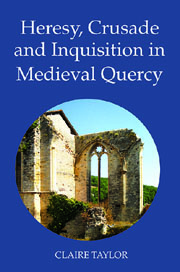Book contents
- Frontmatter
- Contents
- List of illustrations
- Dedication
- Acknowledgements
- Prefatory Note on Words
- List of Abbreviations
- Map 1 Medieval Quercy
- Map 2 Gourdon and its sphere
- The house of Gourdon
- Introduction
- 1 Investigating medieval Quercy: questions about sources
- 2 Medieval Quercy
- 3 War and its aftermath
- 4 ‘Heretical’ Quercy: the evidence gathered by c.1245
- 5 Heresy: a social and cultural life
- 6 Heresy and what it meant
- 7 The reshaping of Quercy
- Conclusion
- Bibliography
- Index
- YORK MEDIEVAL PRESS: PUBLICATIONS
7 - The reshaping of Quercy
Published online by Cambridge University Press: 05 February 2013
- Frontmatter
- Contents
- List of illustrations
- Dedication
- Acknowledgements
- Prefatory Note on Words
- List of Abbreviations
- Map 1 Medieval Quercy
- Map 2 Gourdon and its sphere
- The house of Gourdon
- Introduction
- 1 Investigating medieval Quercy: questions about sources
- 2 Medieval Quercy
- 3 War and its aftermath
- 4 ‘Heretical’ Quercy: the evidence gathered by c.1245
- 5 Heresy: a social and cultural life
- 6 Heresy and what it meant
- 7 The reshaping of Quercy
- Conclusion
- Bibliography
- Index
- YORK MEDIEVAL PRESS: PUBLICATIONS
Summary
Between c.1200 and c.1250, because of what happened to it in military and political terms, Quercy ceased to be a borderland between Aquitaine and Languedoc, politically influenced by both Toulouse and the Poitevin-ruled Limousin. Instead, even its northern lords reorientated themselves towards Languedoc. They did so in confessional terms also. The latter in particular is almost incredible when we consider the devotional life of Quercy south of the Dordogne, focused on the Cistercians of the Limousin and influenced politically by its viscounts, whom the lords of Gourdon joined in the defence of orthodoxy in 1209. I have highlighted the fact that the lords of Gourdon cannot be demonstrated to have encountered heretics at close quarters until the 1214 siege of Casseneuil in the Agenais, during which Ratier de Castelnau-Montratier, along with numerous perfecti, was protected by its lord Hugues de Rovignan. But, by the end of the wars, Quercy had been corrupted and its leading castellans induced to likewise protect, if not actually ‘believe in’, the quarry the crusaders sought. We shall now address the reasons for this volte face.
The Social Impact of the Invasion
As observed in Chapter 3, in August 1212 Montcuq was abandoned by its bailli Guiraud de Montfabès and the castrum was given to Baudouin of Toulouse. The lords of Lolmie, a castle pertaining to Montcuq, became Baudouin's vassals. The lords of Mondenard were already his allies, Armand de Mondenard having supported his operation in lower Quercy in 1211. But, along with Ratier de Castelnau-Montratier, who was the most important member of the family of Gourdon in the Vaux, the lords of Lolmie and Mondenard conspired to have their new master murdered in 1214 and saw the plan through.
- Type
- Chapter
- Information
- Heresy, Crusade and Inquisition in Medieval Quercy , pp. 209 - 226Publisher: Boydell & BrewerPrint publication year: 2011



